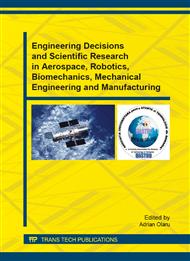[1]
C. Alexandru, I.N. Tatu, Optimal design of the solar tracker used for a photovoltaic string, Journal of Renewable and Sustainable Energy, vol. 5, nr. 2 (2013), p.023133 (1-16).
DOI: 10.1063/1.4801452
Google Scholar
[2]
V.K. Chinnaiyan, J. Jerome, J. Karpagam, An experimental investigation on a multilevel inverter for solar energy applications, Electrical Power and Energy Systems, vol. 47 (2013), pp.157-167.
DOI: 10.1016/j.ijepes.2012.10.025
Google Scholar
[3]
M.A. Ioniţă, C. Alexandru, Optimal design of the mechanical device for a photovoltaic tracking mechanism, Applied Mechanics and Materials, vol. 186 (2012), pp.114-123.
DOI: 10.4028/www.scientific.net/amm.186.114
Google Scholar
[4]
S. Seme, G. Stumberger, A novel prediction algorithm for solar angles using solar radiation and differential evolution for dual-axis sun tracking purposes, Solar Energy, vol. 85, no. 11 (2011), pp.2757-2770.
DOI: 10.1016/j.solener.2011.08.031
Google Scholar
[5]
G.K. Singh, Solar power generation by PV (photovoltaic) technology: A review, Energy, vol. 53 (2013), pp.1-13.
Google Scholar
[6]
E. Calabrò, Determining optimum tilt angles of photovoltaic panels at typical north-tropical latitudes, Journal of Renewable and Sustainable Energy, vol. 1, no. 3 (2009), p.033104 (1-6).
DOI: 10.1063/1.3148272
Google Scholar
[7]
C. Alexandru, Software platform for analyzing and optimizing the mechanical systems, Proceedings of the 10th IFToMM International Symposium on Science of Mechanisms and Machines, Springer, pp.665-677 (2009).
DOI: 10.1007/978-90-481-3522-6_56
Google Scholar
[8]
M. Ceccarelli, Challenges for mechanism design, Proceedings of the 10th IFToMM International Symposium on Science of Mechanisms and Machines, Springer, pp.1-13 (2009).
Google Scholar
[9]
Ş. Staicu, Dynamics of the 6-6 Stewart parallel manipulator, Robotics and Computer-Integrated Manufacturing, vol. 27, no. 1 (2011), pp.212-220.
DOI: 10.1016/j.rcim.2010.07.011
Google Scholar
[10]
M. Meliß, Regenerative Energiequellen - Praktikum, Springer (1997).
Google Scholar
[11]
C. Alexandru, C. Pozna, Simulation of a dual-axis solar tracker for improving the performance of a photovoltaic panel, Proceedings of the Institution of Mechanical Engineers, Part A: Journal of Power and Energy, vol. 224, no. 6 (2010).
DOI: 10.1243/09576509jpe871
Google Scholar


